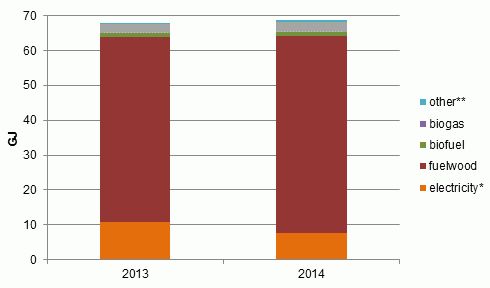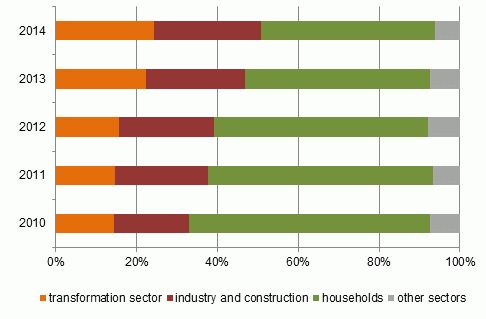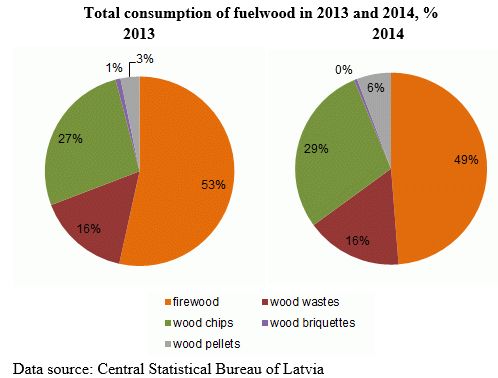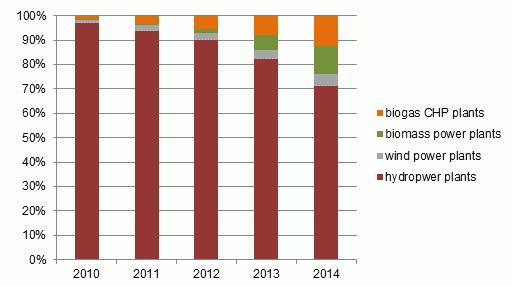Analytics, Energy, Latvia, Markets and Companies
International Internet Magazine. Baltic States news & analytics
Thursday, 18.04.2024, 23:39
Consumption of renewable energy sources increases by 12% over the last 10 years in Latvia
 Print version
Print version
Main RES types – fuelwood and hydro resources – accounted for 34% of total consumption of energy resources in 2014.
 |
| Consumption of renewable energy resources in 2013 and 2014, PJ |
* Hydro power and wind power
** Charcoal, straw, other biomass
Data source: Central Statistical Bureau of LatviaFuelwood is the most commonly used RES in Latvia, and its share in total energy consumption has increased from 23.4% in 2010 to 30.2% in 2014. In 2014 the share of fuelwood in RES consumption was 82.1%, which is 3.4 PJ or 4% more than in 2013.
As compared to 2013 total consumption of fuelwood in 2014 grew by 6%; consumption changes were also recorded in breakdown by sector. The share of fuelwood increased both – in households and in transformation sector for production of heat and electricity. The main fuelwood consumers are households, which mostly use firewood (85%). In 2010 the share of consumed fuelwood in households was 42.9%, in 2013 – 45.4%, and in 2014 – 46.3%.
 |
| Fuelwood consumption in Latvia, % |
Over the last four years the share of fuelwood in transformation sector has increased by 9.8%, in 2014 reaching 24.3% of total consumption in Latvia. In transformation sector mainly wood chips are used (86.5%). The greatest growth in consumption of fuelwood in transformation sector was registered in 2014, when the share of wood chips grew by 25.1% as compared to 2013. This is related to the new CHP plants, which started their operation in 2014, and the annually increasing share of RES, reducing the share of natural gas. Since 2007 installed electrical capacity of RES CHP plants has increased 12 times, in 2014 reaching 121 MW; the amount of electricity produced increased 16 times, reaching 669 GWh, which accounts for 22% of total electricity produced in CHP plants.

Firewood forms the largest share (almost 50%) of total fuelwood consumption. Compared to 2013, firewood consumption in 2014 decreased by 4%, while consumption of wood pellets grew by 3%.
 |
| Electricity produced from renewable energy resources, % |
2 803 GWh of electricity was produced from RES in 2014, which is 20.7% less than in 2013. The share of electricity produced from RES in the total amount of produced electricity accounted for 37.6%, which is 9.1% less than a year before. The greatest share (more than 70%) of electricity from RES is produced in hydropower plants. In 2014 hydropower plants with the capacity over 10 MW (Pļaviņas Hydropower Plant, Riga Hydropower Plant and Ķegums Hydropower Plant) produced 1 925 GWh of electricity or 68.7% of total electricity produced from RES.
Electrical capacity in power plants and CHP plants using RES
|
Electrical capacity (MW) |
1990 |
1995 |
2000 |
2010 |
2011 |
2012 |
2013 |
2014 |
|
Total |
1 487 |
1 508 |
1 515 |
1 22 |
1 642 |
1 701 |
1 764 |
1780 |
|
Hydropower plants |
1 487 |
1 507 |
1 513 |
1 576 |
1 576 |
1 576 |
1,589 |
1590 |
|
Wind power plants |
- |
1 |
2 |
30 |
36 |
59 |
67 |
69 |
|
Biomass power plants and CHP plants |
- |
- |
- |
5 |
5 |
23 |
55 |
63 |
|
Biogas CHP plants |
- |
- |
- |
11 |
25 |
43 |
53 |
58 |
Over the last years capacity of hydropower plants has not changed much; in turn electric capacity of other power plants and CHP plants has grown significantly. For instance, capacity of wind power plants in 2014, as compared to 2013 rose by 3%, and compared to 2012 – by almost 17%. Electrical capacity of biogas CHP plants grew by 9.4%, as compared to 2013. Electrical capacity of biomass power plants and CHP plants grew by 14.5% as compared to 2013, and by 174% as compared to 2012. One of the factors promoting RES development is state support allowing to sell electricity within the mandatory procurement framework.
Directive 2009/28/EC of the European Parliament and of the Council on the promotion of the use of energy from renewable sources stipulates that the share of energy from RES by 2020 must account for at least 40% of final energy consumption. In 2008 the share of RES in Latvia accounted for 29.81%, in 2010 – 32.49%, in 2013 – 37.07%, and also in 2014 this indicator is forecast to show a slight rise. Each Member State must ensure that by 2020 the share of energy produced from RES (biofuel, biogas, electricity produced from RES and consumed in transport) amounts to at least 10% of final consumption of energy in transport (in 2013 Latvia reached 3.08%).
More information on energy sector, including RES, is available in the CSB database Environment and Energy.








 «The Baltic Course» Is Sold and Stays in Business!
«The Baltic Course» Is Sold and Stays in Business!

